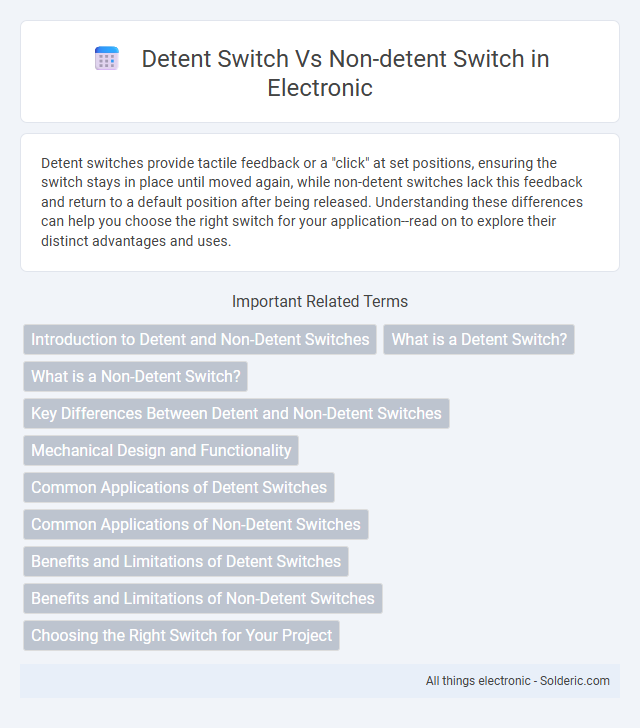Detent switches provide tactile feedback or a "click" at set positions, ensuring the switch stays in place until moved again, while non-detent switches lack this feedback and return to a default position after being released. Understanding these differences can help you choose the right switch for your application--read on to explore their distinct advantages and uses.
Comparison Table
| Feature | Detent Switch | Non-Detent Switch |
|---|---|---|
| Mechanism | Clicks into predefined positions (detents) | Moves smoothly without positional stops |
| Feedback | Tactile feedback with audible click | No tactile or audible feedback |
| Use Case | Position sensing, mode selection | Continuous adjustment, volume control |
| Position Hold | Maintains fixed positions | Returns to original or neutral position |
| Typical Applications | Industrial controls, multi-mode devices | Audio devices, simple on/off controls |
| Installation Complexity | Moderate | Simple |
Introduction to Detent and Non-Detent Switches
Detent switches feature tactile feedback with defined positions, allowing users to feel and maintain specific settings, ideal for precise control applications. Non-detent switches operate smoothly without fixed positions, providing continuous variation useful in scenarios requiring gradual adjustment. Understanding the distinction helps you select the right switch type for your device's functionality and user experience.
What is a Detent Switch?
A detent switch features a mechanism that provides tactile feedback by clicking into designated positions, enhancing user control and precision. Its notched or stepped design allows the switch to stay firmly in place until intentionally moved, making it ideal for applications requiring discrete settings. Compared to non-detent switches, which lack this positional feedback and return to a neutral state, detent switches offer improved operational stability and user confidence.
What is a Non-Detent Switch?
A non-detent switch is a type of momentary switch that returns to its original position once released, providing no tactile locking mechanism. Unlike detent switches, which have distinct click positions for feedback, non-detent switches offer smooth, continuous movement without fixed stops. Your choice between these switches depends on whether you need temporary activation or a maintained position for your application.
Key Differences Between Detent and Non-Detent Switches
Detent switches feature a tactile feedback mechanism with distinct positions or "detents" that provide resistance and a click sensation, enhancing user control and precision. Non-detent switches lack these tactile notches, offering smooth, continuous movement without intermediate stops, which is ideal for applications requiring variable input without fixed steps. The choice between detent and non-detent switches depends primarily on whether tactile feedback and position indication are necessary for the device's functionality.
Mechanical Design and Functionality
Detent switches feature a mechanical design with built-in tactile feedback, utilizing a spring-loaded mechanism that creates distinct, stable positions by engaging with notches or grooves, enhancing user precision and control. Non-detent switches lack this tactile locking feature, resulting in smooth, continuous movement without predefined stopping points, suitable for applications requiring variable input rather than fixed increments. The choice between detent and non-detent switches directly impacts functionality, where detent switches offer reliable positional cues and non-detent switches provide fluid adjustment capabilities.
Common Applications of Detent Switches
Detent switches are commonly used in applications requiring tactile feedback and precise control, such as volume knobs, rotary encoders, and automotive controls. Their distinct click positions help users accurately adjust settings without looking, enhancing user experience in devices like audio equipment and industrial machinery. Your projects benefit from detent switches when reliable positional feedback and repeatable settings are essential.
Common Applications of Non-Detent Switches
Non-detent switches are widely used in applications requiring momentary input, such as keyboard keys, gaming controllers, and control panels where temporary activation is essential. These switches are ideal for functions like reset buttons, doorbells, and vehicle horn buttons, where the switch returns to its default position after being pressed. Their design ensures quick and precise input without mechanical locking, enhancing user experience in interactive devices.
Benefits and Limitations of Detent Switches
Detent switches provide tactile feedback and precise position control, ensuring users can easily identify switch states without visual confirmation. Their primary benefit includes enhanced user experience in applications requiring discrete, repeatable settings, such as audio equipment or control panels. However, detent switches may have limitations in smooth, continuous control scenarios and can wear out detent mechanisms over time, affecting long-term reliability.
Benefits and Limitations of Non-Detent Switches
Non-detent switches provide smooth, continuous movement without tactile feedback, making them ideal for applications requiring precise, variable control such as volume adjustments or dimming lights. Their lack of physical stops allows for seamless transitions but can lead to unintentional position changes, reducing reliability in settings needing fixed positions. While non-detent switches offer versatility and ease of use in dynamic control scenarios, they may lack the positional stability critical for certain industrial equipment or safety switches.
Choosing the Right Switch for Your Project
Choosing the right switch for your project depends on the desired feedback and control precision. Detent switches provide tactile clicks or positions, ideal for applications requiring distinct settings or incremental adjustments, such as volume controls or rotary encoders. Non-detent switches offer smooth, continuous movement without feedback, suitable for variable inputs where subtle changes are needed, like dimmer controls or analog joysticks.
detent switch vs non-detent switch Infographic

 solderic.com
solderic.com